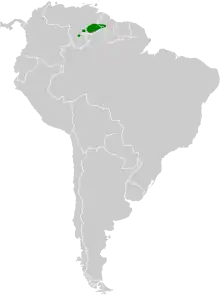| Tepui goldenthroat | |
|---|---|
| Scientific classification | |
| Domain: | Eukaryota |
| Kingdom: | Animalia |
| Phylum: | Chordata |
| Class: | Aves |
| Clade: | Strisores |
| Order: | Apodiformes |
| Family: | Trochilidae |
| Genus: | Polytmus |
| Species: | P. milleri |
| Binomial name | |
| Polytmus milleri (Chapman, 1929) | |
 | |
The tepui goldenthroat (Polytmus milleri) is a species of hummingbird in the subfamily Polytminae, the mangoes. It is found in Brazil, Guyana, and Venezuela.[3][4]
Taxonomy and systematics
The tepui goldenthroat was at one time placed in the monotypic genus Waldronia that was later merged into Polytmus.[5] It is monotypic.[3]
Description
The tepui goldenthroat is 11 to 12 cm (4.3 to 4.7 in) long. Males weigh 4.5 to 6.1 g (0.16 to 0.22 oz) and females 4.1 to 5 g (0.14 to 0.18 oz). Males have bronzy green upperparts and glittering green underparts. The tail is shades of green with a wide white band at the base and white tips. The area around the eye is dusky gray with white streaks above and below it. The female is smaller than the male and has dull white underparts heavily dotted with golden-green, especially on the breast. Juveniles are like the adults but with buffy edges to the head's feathers.[6]
Distribution and habitat
The tepui goldenthroat is found only on the eponymous tepuis of southern and southeastern Venezuela and slightly into western Guyana and extreme northern Brazil. On these isolated flat-topped mountains it inhabits the edge of cloudforest and scrublands with scattered trees at elevations between 1,300 and 2,200 m (4,300 and 7,200 ft).[6]
Behavior
Movement
The tepui goldenthroat is generally sedentary but makes some elevational dispersal after breeding.[6]
Feeding
The tepui goldenthroat is "trap-line" feeder, visiting a circuit of a variety of flowering plants for nectar. It also catches insects on the wing and gleans spiders from vegetation and rock cavities.[6]
Breeding
The tepui goldenthroat breeds in May and June. It builds a cup nest lined with fine fibers and decorated on the outside with lichen. It places it in a branch fork of a shrub, typically between 0.5 and 1 m (1.6 and 3.3 ft) above the ground. The clutch size is two eggs. The incubation time is 15 to 16 days.[6]
Vocalization
The tepui goldenthroat gives a "loud series of 'tsit' or 'tizzie' notes" while foraging.[6]
Status
The IUCN has assessed the tepui goldenthroat as being of Least Concern, though its population size and trend are unknown.[1] It is considered uncommon to locally common in its restricted range.[6]
References
- 1 2 BirdLife International (2016). "Tepui Goldenthroat Polytmus milleri". IUCN Red List of Threatened Species. 2016: e.T22687485A93154296. doi:10.2305/IUCN.UK.2016-3.RLTS.T22687485A93154296.en. Retrieved 16 December 2021.
- ↑ "Appendices | CITES". cites.org. Retrieved 2022-01-14.
- 1 2 Gill, F.; Donsker, D.; Rasmussen, P. (July 2021). "IOC World Bird List (v 11.2)". Retrieved July 14, 2021.
- ↑ HBW and BirdLife International (2020) Handbook of the Birds of the World and BirdLife International digital checklist of the birds of the world Version 5. Available at: http://datazone.birdlife.org/userfiles/file/Species/Taxonomy/HBW-BirdLife_Checklist_v5_Dec20.zip [.xls zipped 1 MB] retrieved May 27, 2021
- ↑ Remsen, J. V., Jr., J. I. Areta, E. Bonaccorso, S. Claramunt, A. Jaramillo, D. F. Lane, J. F. Pacheco, M. B. Robbins, F. G. Stiles, and K. J. Zimmer. Version 24 August 2021. A classification of the bird species of South America. American Ornithological Society. https://www.museum.lsu.edu/~Remsen/SACCBaseline.htm retrieved August 24, 2021
- 1 2 3 4 5 6 7 Schuchmann, K.L., P. F. D. Boesman, and G. M. Kirwan (2020). Tepui Goldenthroat (Polytmus milleri), version 1.0. In Birds of the World (J. del Hoyo, A. Elliott, J. Sargatal, D. A. Christie, and E. de Juana, Editors). Cornell Lab of Ornithology, Ithaca, NY, USA. https://doi.org/10.2173/bow.tepgol1.01 retrieved December 16, 2021
